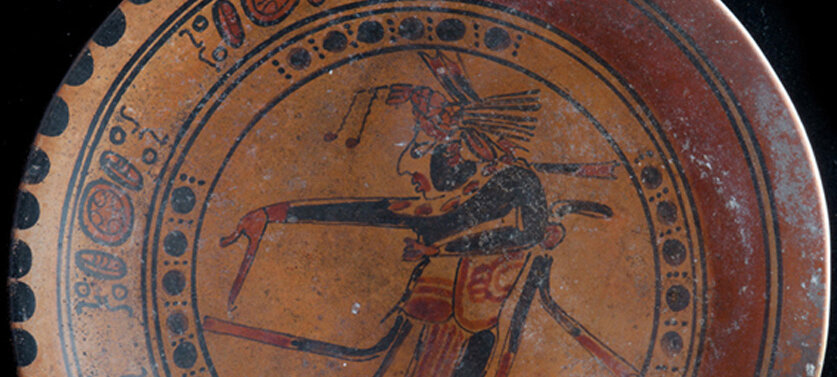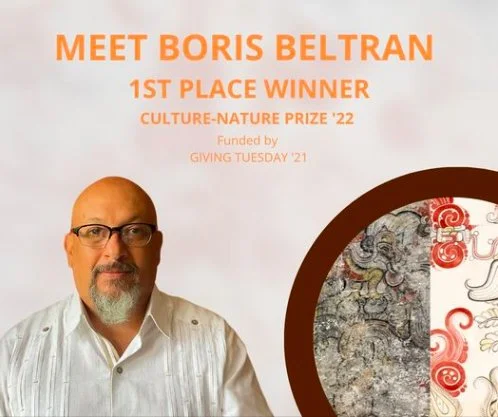
Areas of Research
Current Initiative: Murals in Landscape
San Bartolo and Xultun were centers of art and writing for more than 1200 years. The outstanding discovery of well-preserved murals at each site has contributed greatly to our understanding of the development of wall painting traditions, what materials were used, and how art factored into public narratives of statecraft at key moments in Maya history.
Our current research examines the role of art, urban design, and landscape shrines under, “Murals in Landscape: An investigation of human-nature relationships in Maya myth and design at San Bartolo, Guatemala.” In this multidisciplinary effort, we combine archaeology and ethnography to investigate a newly discovered road system and previously undocumented art and architecture at the ancient Maya site of San Bartolo, Guatemala. The team is excavating road/termini groups, documenting several new stone monuments located at periphery groups, and considering the landscape within cosmologies represented in the murals. In collaboration with Indigenous and local communities, this project explores multiple views on human-nature relationships, Maya art, and placemaking practices.

3 Research objectives within “Murals in Landscape”
Creating a visual dictionary of species & monitoring biodiversity: Team members and local Petén community members are currently co-creating a dictionary of animals and plants represented in the San Bartolo murals. As we identify flora and fauna depicted in the painting, we look outward to the biodiversity of the Maya Biosphere Reserve today. Trail cams are playing an important role in our community documentary activities and we have cameras placed in different ecozones throughout the site. This means more tapir selfies!
Providing an architectural walking tour of ancient masterpieces: We are developing a web-based platform that will interactively present the San Bartolo murals and the Los Árboles temple friezes at Xultun, Guatemala. These important artifacts of Indigenous Maya cultural heritage are nearly impossible to access and visitors to the sealed tunnels threaten their very preservation. Our innovative digital models will expand virtual access to scholars, students, and the public for research, teaching, and learning.
Land use modeling: The longevity of settlement at San Bartolo-Xultunis a story of agricultural sustainability, spanning approximately 3000 years of occupation and supporting a dense urban population for much of the 6th to 9th centuries. Recently acquired lidar data revealed the extent of land modification in the form of terraces and water management systems across the SBX region. We are combining ancient human modifications of landscape with current forest ecology studies to understand greater cycles of agroforestry past and present in the MBR.
Recent Publications.
Recognition for our work
The San Bartolo-Xultun team has garnered recognition for the quality of our research outcomes and contributions to heritage preservation.
Top Discoveries
The SBX publication on a rare calendar date among the mural fragments excavated from San Bartolo received international attention. The mural fragment painted with a number and a day sign, “7 Deer” corresponds to the K’iche’ Maya day Wuqub’ Kej, marking the first day of a year over 22 centuries ago. The “7 Deer” day record represents the earliest securely dated example of the Maya calendar and is important in understanding the development of the 260-day count and associated aspects of Mesoamerican religion and cosmological science. Our research was recognized by Archaeology magazine as one of the Top Ten Discoveries of 2022 and selected among five global finalists for the International Archaeological Discovery Award Khaled al-Asaad, winning the people’s choice award in 2023.
ICOMOS Culture-Nature Prize
Our team was honored to receive international recognition for “significant contributions to the heritage field in innovative and effective ways.” The ICOMOS Culture-Nature prize was used by the SBX team to begin co-creating an illustrated dictionary of the San Bartolo mural biota and topographic features, paired with a species inventory from our study area within the Maya Biosphere Reserve. The visual dictionary is underway! The San Bartolo-Xultun Archaeological Project is dedicated to the study, conservation, and dissemination of these murals, the ancient cities where they were created, and the natural habitat.

The murals at San Bartolo and Xultun have changed our understanding of Maya history.
The artists and scribes of San Bartolo and Xultun created masterpieces in paint, plaster, clay, and stone that provide a window into belief systems and socio-political changes in ancient Maya society. The rare preservation of multiple wall paintings at SBX dating from the 4th century BCE to the 8th century CE represent unique cultural patrimony and exceptional testimony of ancient Maya artistic works.
PRASBX pairs an extensive program of mural scholarship and conservation with its investigative research goals. We seek to understand the greater social dynamics of San Bartolo-Xultun during a time of initial settlement and growth in the Preclassic period, through social upheaval in the 2nd-3rd century CE, and as power was consolidated under dynastic rule during the Classic period. Through archaeology, we investigate the interplay between social systems, visual media, and ecology that unfolded at this lowland Maya city during the first millennium CE. We will be adding resources here in the near future!









